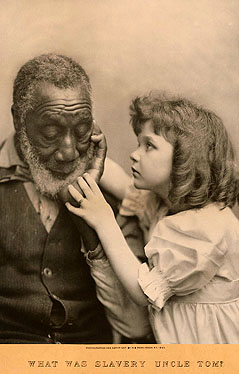 UVA Special Collections TO SEE ENLARGEMENT CLICK HERE |
The goal of this exhibit is to suggest how the various popular versions of Stowe's story between the mid-19th and the early-20th centuries gave white America an on-going occasion to define and re-define "slavery." Stowe used the word "exhibit" herself when describing her goal. Referring to herself in the third person at the end of the novel, she said she had written it to show people what slavery was: . . . when she heard, with perfect surprise and consternation, Christian and humane people actually recommending the remanding escaped fugitives into slavery, as a duty binding on good citizens, . . . she could only think, These men and Christians cannot know what slavery is; if they did, such a question could never be open for discussion. And from this arose a desire to exhibit it in a living dramatic reality. |
|
What slavery was has long been one of the largest questions Americans need to ask. When the novel was written, there were more than three million slaves -- each of whom knew slavery firsthand. Most southern whites, slave-owners and non-slave owners, were personally familiar with various aspects of what politicians called the "peculiar institution." For over a million northerners during the 1850s, however, while the conflicted issue of slavery was growing more and more urgent, Stowe's novel served to define what it was the nation was arguing about. |
|
|
The question of what slavery was remained very loaded even after the institution itself had been abolished. Stowe's novel continued to be read by a wide audience until the 1920s. Just as significantly, it was repeatedly performed on stage and in silent movies. As popular cultural spectacle, Uncle Tom's Cabin offered the nation a set of images that claimed to represent, or re-present, its past. The subtitle of the earliest film version of the novel, for example, a 1903 production by Thomas Edison's company, is Slavery Days, and the claim to historical accuracy implicit in that was often made explicitly by the "Tom Shows" that were seen by millions after the Civil War. At right, for instance, is a detail from a broadside for Downie's Spectacular Uncle Tom's Cabin Company, which promises Americans in the 1880s not just a moral entertainment, but also " INSTRUCTIONS IN AMERICAN HISTORY." |
 Harry Birdoff Collection TO SEE ENTIRE POSTER CLICK HERE |
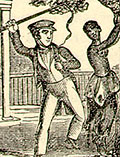 Figure 1 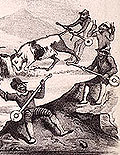 Figure 2 |
Representations of Slavery before Uncle TomDuring the 1830s and 1840s, two very different depictions of slavery competed for the attention of the white northern public. Both created their own stereotypes. The abolitionists who organized America's Anti-Slavery Societies tried to arouse an essentially indifferent populace to the evil of slavery by focusing on the cruelties inflicted on the enslaved. Acts of physical brutality occupy a central place in slave autobiographies like FREDERICK DOUGLASS'S NARRATIVE. Abolitionists recognized the persuasive power of pictures, and in their periodicals, almanacs and other texts the image of the master, mistress or overseer beating a slave occurs often (see Figure 1). During the same decades, blackface minstrelsy was becoming the most popular form of mass entertainment in the country. Although a few minstrel songs refer to the sufferings of slavery, the white men who blackened their faces with burnt cork typically portrayed slaves as "happy darkies" singing and dancing (see Figure 2). On the minstrel stage the only unhappy blacks tend to be the ones who've fled into the north to escape slavery, and who long nostalgically for "the old plantation" -- as in Stephen Foster's OLD FOLKS AT HOME. |
 Figure 3  Figure 4  Figure 5  Figure 6 |
Representations of Slavery & Uncle TomStowe herself said her goal was to "show [slavery] fairly" in the novel. She begins with the Shelby plantation in Kentucky, with what IN CHAPTER ONE she calls "the mildest form of slavery," and her narrative includes examples of affectionate relations between slaves and their masters -- especially Tom and Eva (see Figure 3). The comforting image of Tom and Eva together was probably the most widely reproduced of all the novel's scenes. According to the account Stowe provided in 1878 in IN AN INTRODUCTION to a new edition, however, the story began with a vision of a slave being beaten to death (see Figure 4). In the same introduction she reports the reaction of the first "readers" of Uncle Tom's Cabin, her own two sons, to whom she read the scene aloud: "Oh! mamma, slavery is the most cursed thing in the world!" To bring the reading public to the same conclusion, Stowe narrates the slaves' physical suffering, but focuses even more dramatically on the emotional horrors inflicted on slaves, especially on mothers: on what a lady IN CHAPTER TWELVE calls "its outrages on the feelings and affections." Hammatt Billings' 1852 illustrations for the novel often depict slaves deprived of their children or forced, like Prue, helplessly to watch them die (Figure 5). Figure 6 is from an ornamental mantel screen, depicting the scene Haley remembers IN CHAPTER EIGHT of the mother who killed herself and her child rather than allow him to sell them apart. The existence of such "Tomitudes" (including figurines like the one displayed at the start of this exhibit) shows how Stowe's novel brought images of slave anguish into the parlors of the northern middle class. |
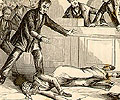 Figure 7 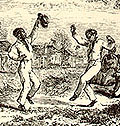 Figure 8 |
Representing Slavery after Uncle TomIn CHAPTER ONE of her 1854 Key to Uncle Tom's Cabin, Stowe herself called the novel's "representation of slavery" inadequate, though only because, while she had shown the best aspects of slavery, she had not dared to reveal the worst. The Key itself was her response to wide-spread attacks on her novel's veracity. PRO-SLAVERY REVIEWS treated her book not simply as a fiction, but as a lying mis-respresentation. Apologists for the status quo, north and south, attacked her version of slavery in a number of forums. Between 1852 and the Civil War, at least twenty novels were published to provide alternative narratives of the plantation. They relied heavily on the stereotypes that minstrelsy had developed: blacks who escaped to the north were invariably miserable (see Figure 7), while enslaved blacks in the care of their kindly masters were almost invariably happy, and always had time and energy to dance (see Figure 8). Almost invariably happy, because these novels do cite one new cause of slaves' suffering: MEDDLING ABOLITIONISTS. Minstrelsy remained a very popular form of entertainment, and a few of these "Anti-Tom novels" were popular in the north, but the images of suffering bodies and broken hearts created by Uncle Tom's Cabin remained vivid in the minds of millions of northerners. |
 Figure 9  Figure 10  Figure 11  Figure 12 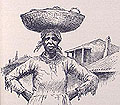 Figure 13 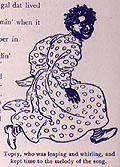 Figure 14 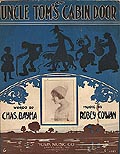 Figure 15  Figure 16 |
Uncle Tom & Re-presenting Slavery after AbolitionOver a million Americans read Uncle Tom's Cabin before slavery was abolished. While it's impossible to be precise, it's a sure bet that many times that number saw Stowe's story performed by one of the hundreds of "Tom Shows" that began travelling across the country soon after the Civil War ended. One source of the popularity of these shows was doubtless that they provided a means to make sense of "slavery" as a central fact of the national past. Their authenticity was often advertised as part of the attraction. Although white actors continued to play all the speaking parts in most companies, the stage shows often included groups of blacks as singers and dancers, and these performers were typically billed as "former slaves" or "genuine Southern colored people" now re-enacting slavery on the basis of their own experience (see Figure 9).According to these representations, slavery included cruelties. Simon Legree and his whip were always prominent parts of the show (see Figure 10), which always climaxed with Tom being beaten to death. In the first chapter of his 1907 autobiography, Nat Love briefly describes his childhood as a slave in Tennessee; after fully registering the physical and moral horrors of slavery, HIS ACCOUNT ENDS with an enthusiastic endorsement of "the play of 'Uncle Tom's Cabin'" as true to his life.On the other hand, with the striking exception of Simon Legree's, the plantation appears in most of these shows as a happy place. In the novel only little Harry and Topsy ever dance, and (except when Legree demands his slaves sing a lively song) the slaves' singing expresses their deep longing for a better world. Beginning at the latest in the 1870s, however, images of singing and dancing slaves appear repeatedly at the center of the show. They dance outside Uncle Tom's cabin (see Figure 11) -- they even dance before the auction block (see Figure 12). It seems as if the "Tom Shows" collapsed minstrelsy's pro-slavery depiction of "happy darkies" and Stowe's anti-slavery depiction of Tom's suffering into one spectacular entertainment. Readers of the novel were also encouraged to re-view its subject. By the 1890s, after Stowe's text was out of copyright, many of the new editions featured illustrations that toned down, if they didn't eliminate, the depictions of anguish earlier readers encountered -- in Figure 13, for example, Prue remains poorly clothed, but the image of her dying infant has been erased.Another place to watch America adapting and revising Stowe's story to meet new cultural circumstances is the CHILDREN'S BOOK section of this archive. Two different writers, both British, published children's versions within a year of the novel's original publication; they are explicitly abolitionist. Children are taught a far different version of slavery in most of the adapations that appeared half a century later. For example, in 1901 Grace Duffie Boylan added a new last chapter to her Young Folks' Uncle Tom's Cabin ( Figure 14). In a scene that takes place on the Shelby plantation after the Civil War and Emancipation, North and South are reunited when Miss Ophelia and Mrs. Shelby meet and become friends, and the logic of Jim Crow segregation by means of which the racial order of the old plantation was being reconstructed is justified when Topsy reverts to her old self, dancing with "all her old time spirit" when the former slaves (still living in the quarters) start playing the banjo. As Mrs. Shelby says, "She is on her native heath now, and this is the Topsy that I hoped to see."During the 1850s Stowe's novel brought the evil of slavery home for the first time to many white northerners. On the basis of the material in this archive, however, it could be argued that after the Civil War Uncle Tom's Cabin served white Americans, north and south, chiefly as a defense against feeling any collective guilt about slavery. Audiences probably left most "Tom Shows" feeling that Legree was an evil man, but slavery itself an essentially benign institution. Stowe's story might even have become part of the cultural project that culminates in the building of Tara in Gone With the Wind: the construction of the myth of the old plantation as America's Camelot. There was no protest, for example, when Joel Chandler Harris, in HIS 1881 INTRODUCTION to the first of his best-selling Uncle Remus books about the pre-war south, identified his work as a supplement to "Mrs. Stowe's wonderful defense of slavery." In the 20th century songs that the archive contains, you can hear America's nostalgia for what one of them calls "those happy days before emancipation" for yourself (see Figure 15)Perhaps the furthest anyone went toward trying to rewrite Stowe is an essay by James Allen Lane that appeared in The Century Magazine in 1887. Lane concedes that there is some truth to Stowe's account. Slaves like Tom, he says, really existed. But he insists they were "never sold by their Kentucky masters to the plantations of the South, but remained unsold down to the last days of slavery." In one of his article's illustrations (by E. W. Kemble, the original illustrator of Mark Twain's Huck Finn) readers could see Tom, still very much alive in the present, still playing with an infant on his knee, as Stowe had shown him in Chapter Four (see Figure 16). By the logic of Lane's representation, even Tom would be nostalgic for "slavery days." |